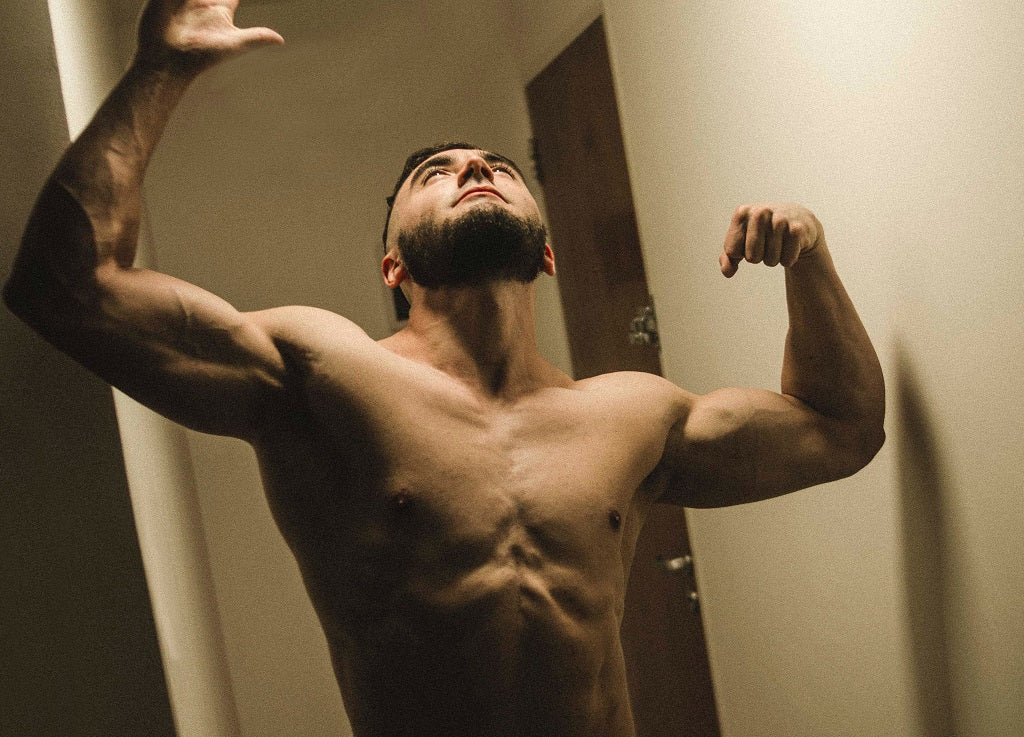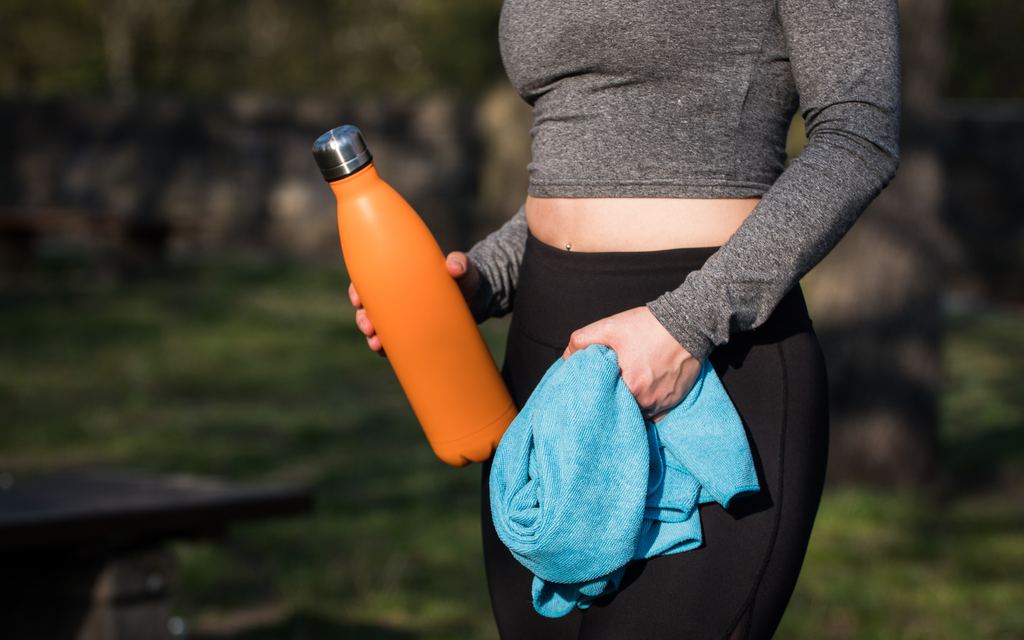Table of Contents:[hide]
Whether from seeing it at the gym or in various movies, you’re likely familiar with the vascular look. Simply put, this is when you have prominent veins bulging out from a body part, such as your arms. If you’ve ever wondered how to get more vascular, you’ve come to the right place.
4 Factors that Affect How to Get More Vascular
Becoming more vascular isn’t just found in workout routines or genetics. Your nutrition and water intake can also play a vital role in exactly how ripped and lean you look. We’ll explain four key factors that it takes to get a ripped, veiny body.
Body Fat Percentage
To become more vascular, you need to take a look at your body fat percentage. Roughly speaking, if you are over 15% body fat, very little vascularity will be visible. If you are above this percentage, finding ways to reduce your body fat is key in becoming more vascular.
To eliminate some body fat, focus on two main things: your diet and your workouts.
If you are looking to lose body fat check out of great body fat burner supplements.

Change Your Diet
If salty, sugary, and carb heavy foods compose a good portion of your diet, focus on reducing your intake of all three of these items immediately. From there, work on eating more lean proteins and vegetables.
Also, remember not to skip meals, especially if you are working out. This can cause your metabolism to slow down and you can gain weight.
Consume Nitrates
One of the best ways you can stimulate your body and improve vascularity is by consuming extra nitrates. Consuming these increases the amount of nitric oxide that circulates throughout your blood. How does this help?
Basically, improved nitric oxide circulation causes your blood vessels to widen and improves the pump you get from your workouts. They also dilute your blood vessels and improve blood vessel production. All these factors combine to improve muscle definition, vein prominence, and overall workout energy.
The types of foods that are rich in nitrates are often vegetables. In other words, foods you should already be eating to maintain a healthy diet. In particular, spinach, lettuce, and beetroots are excellent choices to improve the amount of nitrates in your diet.
Schedule Workouts
Along with eating healthy, you’ll want to workout regularly. This will help to burn off unwanted fat and build muscle. Here are various exercises you can do to burn fat:
- Jump rope
- Medicine ball slams
- Goblet squats
- Squats
- Battle rope waves
- Burpees
Blood Vessel Size
The overall size of your blood vessels matter when wanting to look more vascular. The larger your vessels are, the more prominent they will be under your skin. If they are smaller, you will generally need to have less body fat for them to be more visible.
When it comes to the size of your vessels, there are two different situations to take into account:
- Their size when relaxed
- Their size when pumped from exercise
Your vessels expand when they are pumped up (this is known as vasodilation). This is typically temporary, and when you stop working out, they will reduce back to their relaxed size. If you pump your muscles for a long period of time, you can eventually widen your blood vessels. This means they will be bigger when in their relaxed state.
Muscle Size
Similar to blood vessels, the bigger your muscles are, the more vascular you will look. Your veins are located near your muscles, so if you have larger muscles, they will push your veins closer to the skin surface.
Chase the Pump
As you workout, determine which areas on your body you want to become more vascular. Pick one of those muscle groups, and at the end of your workout chase the pump to make those veins pop and become more prominent on that specific muscle..
In order to drive a good amount of blood into those muscles, make sure your workout includes a combination of high-intensity lifting exercises and short rest periods.

Water Retention
One of the major roadblocks when it comes to improving vascularity is getting used to lowering your water retention. Your body naturally retains water to stay hydrated throughout the day. This can expand your skin and body and make you appear bloated and less lean than you’d like.
By minimizing your water retention, your body will be able to look more vascular. Your skin will stick your muscles and veins like glue. So how do you lower water retention in a healthy way?
Water retention can be a common problem for bodybuilders, as excess water in the muscles can reduce definition and make it difficult to achieve a lean, ripped appearance. Here are some ways to prevent water retention in bodybuilding:
- Stay hydrated: While it may seem counterintuitive, drinking enough water can actually help to prevent water retention by flushing excess fluids out of the body. Aim to drink at least 8-10 glasses of water per day.
- Limit your sodium intake: Consuming too much sodium can cause your body to retain water, so it's important to limit your intake. Avoid processed foods, which are often high in sodium, and opt for fresh, whole foods instead.
- Avoid alcohol: Alcohol can cause dehydration and disrupt the body's natural fluid balance, which can contribute to water retention.
- Incorporate cardio into your routine: Cardiovascular exercise can help to improve circulation and reduce fluid buildup in the muscles. Aim for at least 30 minutes of moderate-intensity cardio 3-5 times per week.
- Consider using natural diuretics: Certain natural diuretics, such as dandelion root and green tea, may help to reduce water retention in the body. However, it's important to use them cautiously and under the guidance of a healthcare professional.
Remember that water retention can also be caused by underlying medical conditions, such as kidney or liver disease, so if you experience persistent or severe swelling, it's important to consult with a healthcare professional.
Reduce Your Sodium Intake
When you have large amounts of sodium in your diet, cells can temporarily retain water. This is because your cells absorb sodium, and sodium brings water with it.
In order to restore your cells back to their normal state, you need something to counterbalance it. This is where potassium plays an important role in your diet.
Potassium is beneficial for many reasons. Specifically pertaining to water retention, potassium pumps the water out of cells that sodium injected. So, you need to strike a balance with your sodium and potassium levels to ensure that your sodium intake does not outweigh that of potassium.
Stay Hydrated
It’s important to not accidentally dehydrate yourself, as this will negatively affect your workout performance and your overall physical fitness. You might see some movie stars who “dehydrate” before a shirtless scene or battle. Do not copy this.
Even short-term dehydration can be negative for your health. You’re not aiming for dehydration. Instead, you want a balance between constant water intake and constant water removal in the form of sweat and urine.
To that end, it’s still important not to eat too much salt or sodium. The main point to remember is not to cut out salt consumption entirely. It does play an important role in maintaining healthy hydration levels.
Conclusion
To recap, if you’re looking for how to get more vascular, you need to reduce your body fat, increase your blood vessel size, increase your muscle mass, and reduce the amount of water your retain. Focus on these four things, and you’ll be on your way to a vascular body!
Questions and Answers
-
How can I make my body more vascular?
There are a few ways to increase vascularity in your body, including reducing your body fat percentage, increasing your muscle mass, and improving your cardiovascular health. These can all lead to more visible veins and a more vascular appearance. Additionally, certain supplements and foods may also have a positive effect on vascularity.
Source: Healthline
-
Does exercise increase vascularity?
Yes, exercise can increase vascularity by improving blood flow and circulation throughout the body. Regular exercise can also help to increase muscle mass, which can lead to more visible veins. Additionally, certain types of exercise, such as resistance training, can have a more direct effect on vascularity by increasing blood flow to the muscles being worked.
Source: Men's Health
-
What makes you more veiny?
Several factors can make you more veiny, including genetics, body fat percentage, and hydration levels. People with low body fat percentages and well-developed muscles are generally more veiny, as are those with genetics that predispose them to visible veins. Additionally, being well-hydrated can make veins more visible, as can certain medications and medical conditions.
Source: Medical News
-
What in pre workout makes you more vascular?
Many pre-workout supplements contain ingredients that can increase vascularity, such as nitric oxide boosters like L-citrulline and arginine, as well as caffeine, which can help to improve blood flow and circulation. Beta-alanine is another common ingredient in pre-workouts that can increase blood flow and improve muscle endurance, potentially leading to a more vascular appearance.
Source: https://www.bodybuilding.com/content/pre-workout-supplements-are-they-right-for-you.html




